现代材料研究方法TEM1
材料现代测试分析技术-TEM透射电镜

Why?
36
分辨率
球差 色差
像差
像散 电磁透镜也和光学透镜一样,除了衍射 效应对分辨率的影响外,还有像差对分 辨率的影响。由于像差的存在,使得电 磁透镜的分辨率低于理论值。电磁透镜 的像差包括球差、像散和色差。
球差
37
球差是因为电磁透镜的中心区域磁场和边缘区 域磁场对入射电子束的折射能力不同而产生的。 离开透镜主轴较远的电子(远轴电子)比主轴 附近的电子(近轴电子)被折射程度大。
平行电子束形成(TEM-mode)
11
(A)C1会聚,C2欠焦,获得近似平行束; 11 (B)C1会聚,C2聚焦,C3调节获得平行束;
会聚电子束形成(STEM,EDS,NBD,CBD)
12
(A)C1会聚,C2聚焦,获得会聚束; (B)C1会聚,C3调节获得会聚束;
成像系统
13
对电镜: 电子束 聚光镜 物镜 中间镜 投影镜
∆E ∆rC = C c ⋅ α E
像差对分辨率的影响
42
由于球差、像散和色差的影响,物体上的光点在 像平面上均会扩展成散焦斑。 各散焦斑半径折算回物体后可得到由球差、像散 和色差所限定的分辨率。
0.61λ ∆r0 = N sin α
衍射效应造成的散焦斑
1 ∆rS =Csα 3 4
球差效应造成的散焦斑
f ≈K
(IN )2
Ur
式中K是常数,Ur是经相对论校正的电子加速电压,(IN) 是电磁透镜的激磁安匝数。 改变激磁电流可以改变电磁透镜的焦距。而且电磁透镜的焦 距总是正值,这意味着电磁透镜不存在凹透镜,只是凸透镜。
样品倾斜装置及样品台
21
XRD、SEM、TEM、VSM、XPS、ICP等测试方法介绍

常用的xrd分析软件有4种:我认为是最原始的了。
它是在衍射图谱标定以后,按照d值检索。
一般可以有限定元素、按照三强线、结合法等方法。
所检索出的卡片多时候不对。
一张复杂的衍射谱有时候一天也搞不定。
match可以实现和原始实验数据的直接对接,可以自动或手动标定衍射峰的位置,对于一般的图都能很好的应付。
而且有几个小工具使用很方便。
如放大功能、十字定位线、坐标指示按钮、网格线条等。
最重要的是它有自动检索功能。
可以帮你很方便的检索出你要找的物相。
也可以进行各种限定以缩小检索范围。
如果你对于你的材料较为熟悉的话,对于一张含有4,5相的图谱,检索也就3分钟。
效率很高。
而且它还有自动生成实验报告的功能!score几乎search match中所有的功能,highscore都具备,而且它比searchmatch 更实用。
(1)它可以调用的数据格式更多。
(2)窗口设置更人性化,用户可以自己选择。
(3)谱线位置的显示方式,可以让你更直接地看到检索的情况(4)手动加峰或减峰更加方便。
(5)可以对衍射图进行平滑等操作,是图更漂亮。
(6)可以更改原始数据的步长、起始角度等参数。
(7)可以进行0点的校正。
(8)可以对峰的外形进行校正。
(9)可以进行半定量分析。
(10)物相检索更加方便,检索方式更多。
(11)可以编写批处理命令,对于同一系列的衍射图,一键搞定。
和highscore相比自动检索功能少差,但它有比之更多的功能。
(1)它可以进行衍射峰的指标化。
(2)进行晶格参数的计算。
(3)根据标样对晶格参数进行校正。
(4)轻松计算峰的面积、质心。
(5)出图更加方便,你可以在图上进行更加随意的编辑。
xrd 即X-ray diffraction ,X射线衍射,通过对材料进行X射线衍射,分析其衍射图谱,获得材料的成分、材料内部原子或分子的结构或形态等信息的研究手段。
X射线是一种波长很短(约为20~┱)的电磁波,能穿透一定厚度的物质,并能使荧光物质发光、照相乳胶感光、气体电离。
材料方法-第5章-TEM-1(2010)
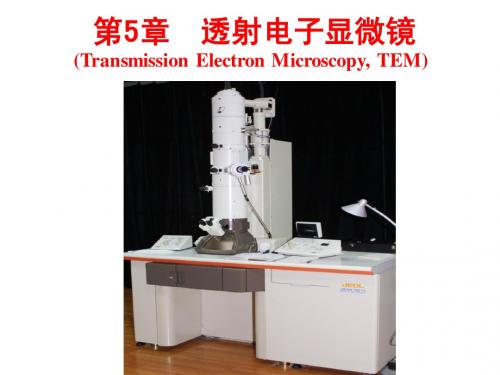
(3)投影镜 投影镜的作用是把经中间镜放大(或缩小) 投影镜的作用是把经中间镜放大(或缩小) 把经中间镜放大 的像(电子衍射花样)进一步放大, 的像(电子衍射花样)进一步放大,并投影到荧 光屏上。它和物镜一样,是一个短焦距的强磁透 光屏上。它和物镜一样,是一个短焦距的强磁透 投影镜的激磁电流是固定的。 镜。投影镜的激磁电流是固定的。因为成像电子 束进入投影镜时孔镜角很小( rad) 束进入投影镜时孔镜角很小(约10-3rad),因此 它的景深和焦距都非常大。 它的景深和焦距都非常大。即使改变中间镜的放 大倍数,使显微镜的总放大倍数有很大的变化, 大倍数,使显微镜的总放大倍数有很大的变化, 也不会影响图像的清晰度。 也不会影响图像的清晰度。
透射电镜成像系统的两种基本操作 (a)将衍射谱投影到荧光屏 (b)将显微像投影到荧光屏 (a)将衍射谱投影到荧光屏 (b)将显微像投影到荧光屏
(1)物镜 物镜是用来形成第一幅高分辨率电子显微图 像或电子衍射花样的透镜。 像或电子衍射花样的透镜。透射电子显微镜分辨 本领的高低主要取决于物镜。 本领的高低主要取决于物镜。因为物镜的任何缺 陷都被成像系统中其它透镜进一步放大。 陷都被成像系统中其它透镜进一步放大。欲获得 物镜的高分辨率,必须尽可能降低像差。 物镜的高分辨率,必须尽可能降低像差。通常采 强激磁,短焦距的物镜。 用强激磁,短焦距的物镜。 物镜是一个强激磁短焦距的透镜, 物镜是一个强激磁短焦距的透镜,它的放大 倍数较高,一般为100 300倍 目前, 100倍数较高,一般为100-300倍。目前,高质量的物 镜其分辨率可达0.1nm左右。 0.1nm左右 镜其分辨率可达0.1nm左右。
1、
透射电子显微镜工作原理
成像原理与光学显微镜类似: 成像原理与光学显微镜类似: • 它们的根本不同点在于光学显微镜以可见光作照 明束,透射电子显微镜则以电子为照明束。在光 明束,透射电子显微镜则以电子为照明束。 电子为照明束 学显微镜中将可见光聚焦成像的是玻璃透镜, 学显微镜中将可见光聚焦成像的是玻璃透镜,在 电子显微镜中相应的为磁透镜。 电子显微镜中相应的为磁透镜。 磁透镜 • 由于电子波长极短,同时与物质作用遵从布拉格 由于电子波长极短, Bragg)方程,产生衍射现象, (Bragg)方程,产生衍射现象,使得透射电镜自 身在具有高的像分辨本领的同时兼有结构分析的 身在具有高的像分辨本领的同时兼有结构分析的 高的像分辨本领的同时兼有 功能。 功能。
材料现代研究方法
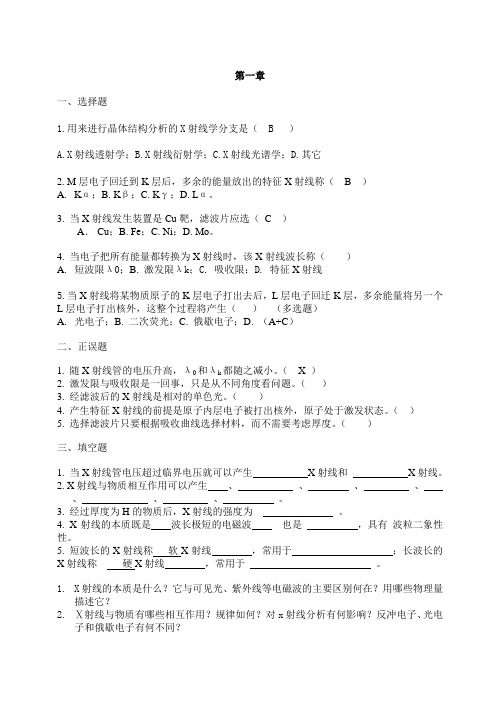
第一章一、选择题1.用来进行晶体结构分析的X射线学分支是( B )A.X射线透射学;B.X射线衍射学;C.X射线光谱学;D.其它2. M层电子回迁到K层后,多余的能量放出的特征X射线称( B )A.Kα;B. Kβ;C. Kγ;D. Lα。
3. 当X射线发生装置是Cu靶,滤波片应选(C )A.Cu;B. Fe;C. Ni;D. Mo。
4. 当电子把所有能量都转换为X射线时,该X射线波长称()A.短波限λ0;B. 激发限λk;C. 吸收限;D. 特征X射线5.当X射线将某物质原子的K层电子打出去后,L层电子回迁K层,多余能量将另一个L层电子打出核外,这整个过程将产生()(多选题)A.光电子;B. 二次荧光;C. 俄歇电子;D. (A+C)二、正误题1. 随X射线管的电压升高,λ0和λk都随之减小。
(X )2. 激发限与吸收限是一回事,只是从不同角度看问题。
()3. 经滤波后的X射线是相对的单色光。
()4. 产生特征X射线的前提是原子内层电子被打出核外,原子处于激发状态。
()5. 选择滤波片只要根据吸收曲线选择材料,而不需要考虑厚度。
()三、填空题1. 当X射线管电压超过临界电压就可以产生X射线和X射线。
2. X射线与物质相互作用可以产生、、、、、、、。
3. 经过厚度为H的物质后,X射线的强度为。
4. X射线的本质既是波长极短的电磁波也是,具有波粒二象性性。
5. 短波长的X射线称软X射线,常用于;长波长的X射线称硬X射线,常用于。
1.X射线的本质是什么?它与可见光、紫外线等电磁波的主要区别何在?用哪些物理量描述它?2.Ⅹ射线与物质有哪些相互作用?规律如何?对x射线分析有何影响?反冲电子、光电子和俄歇电子有何不同?3. 如果用1mm 厚的铅作防护屏,试求Cr K α和Mo K α的穿透系数。
4. 试计算Cu 的K 系激发电压。
(答案:8980Ⅴ)5. 试计算Cu 的K αl 射线的波长。
(答案:0.1541 nm ).第二章一、选择题1.有一倒易矢量为*+*+*=*c b a g 22,与它对应的正空间晶面是( )。
材料现代分析方法(1)

材料现代分析方法重点(彭美勋部分)名词解释部分1,石墨单色器与分光晶体石墨单色器:利用衍射方法过滤杂色X射线的晶体单色器,比较滤波片更有效的消除x射线背底。
2,明场像与暗场像明场像:在电子显微镜中,用透过样品的非散射电子以及在物镜孔径角区域内的散射电子的电子束对样品所形成的像暗场像:在电子显微镜中,仅利用透过样品的散射电子束对样品所形成的像。
3,质厚衬度与衍射衬度以及原子序数衬度质量衬度:由于样品不同微区间存在原子序数或厚度的差异而形成的衍射衬度:由样品各衍射束强度差异形成的衬度。
影响因素主要是晶体取向和结构振幅原子序数衬度:由于试样表面物质原子序数或化学成分差别而引起的衬度4,wds与edsWds:波谱仪Eds:能谱仪能谱仪的优点有:分析速度快,灵敏度高,谱线重复性好。
缺点有:能量分辨率低,峰背比低。
工作条件要求严格。
波谱仪的优点有:波长分辨率很高。
5,二次电子与背散射电子二次电子成:在单电子激发过程中被入射电子轰击出来的核外电子背散射电子成:被固体样品原子反射回来的一部分入射电子5.1,二次电子像与背散射电子像答:二次电子象:是表面形貌衬度,它是利用对样品表面形貌变化敏感的物理信号作为调节信号得到的一种象衬度背散射电子像:背散射电子像的形成,就是因为样品表面上平均原子序数Z大的部位而形成较亮的区域,产生较强的背散射电子信号;而平均原子序数较低的部位则产生较少的背散射电子,在荧光屏上或照片上就是较暗的区域,这样就形成原子序数衬度。
6,物相定性分析与物相定量分析物相定性分析:鉴定试样中各种组成的构成,包括的元素、根或官能团等的分析。
物相定量分析:测定试样中各种组分(如元素、根或官能团等)含量的操作。
6.1,单晶衍射和多晶衍射单晶衍射:每一个斑点对应一个衍射面多晶衍射:每一个圆环是一系列等间距的衍射面问答部分7,扫描电子显微镜与透射电子显微镜异同答:相同之处:都是电真空设备,使用绝大部分部件原理相同,例如电子枪,磁透镜,各种控制原理,消象散,合轴等等。
tem工作原理(一)
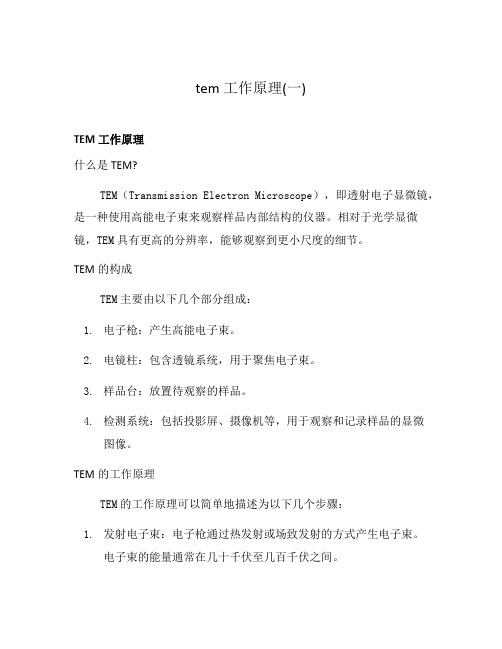
tem工作原理(一)TEM工作原理什么是TEM?TEM(Transmission Electron Microscope),即透射电子显微镜,是一种使用高能电子束来观察样品内部结构的仪器。
相对于光学显微镜,TEM具有更高的分辨率,能够观察到更小尺度的细节。
TEM的构成TEM主要由以下几个部分组成:1.电子枪:产生高能电子束。
2.电镜柱:包含透镜系统,用于聚焦电子束。
3.样品台:放置待观察的样品。
4.检测系统:包括投影屏、摄像机等,用于观察和记录样品的显微图像。
TEM的工作原理TEM的工作原理可以简单地描述为以下几个步骤:1.发射电子束:电子枪通过热发射或场致发射的方式产生电子束。
电子束的能量通常在几十千伏至几百千伏之间。
2.加速电子束:电子束经过电场加速,使其达到高能状态,以便穿透样品。
3.聚焦电子束:透镜系统中的聚焦透镜,例如磁透镜,将电子束聚焦为一小束,并控制其对样品的定位和聚焦质量。
4.透射样品:聚焦的电子束穿透样品,与样品内的原子和结构相互作用。
5.接收电子信号:穿过样品的电子束形成透射电子图像,通过投影屏或摄像机等检测系统进行接收。
6.图像处理和分析:对接收到的透射电子图像进行处理和分析,得到样品的显微结构信息。
TEM的优势和局限性TEM具有以下优点:•高分辨率:相比于光学显微镜,TEM具有更高的分辨率,可以观察到更小尺度的细节。
•大深度:TEM可以观察样品的内部结构和晶体缺陷等细节,有助于研究材料的性质和特性。
•成像方式多样:除了透射电子图像,TEM还可以进行选区电子衍射、仰视电子显微镜等多种成像方式。
然而,TEM也存在一些局限性:•样品制备难度高:样品需要经过复杂的制备过程,包括切片、薄化等步骤,以便电子束能够穿透样品。
•易受到空气和水蒸气的影响:由于电子束极为灵敏,TEM必须在高真空环境中操作,以避免电子束与空气和水蒸气反应。
•样品对电子束的敏感性:高能电子束对样品的辐射损伤较大,有可能导致样品结构发生变化。
TEM方法介绍及案例详细分析

TEM、HRTEM、STEM的实战运用说明案例1注:本节内容以李亚栋院士2011年发表在Chem.Mater.上的一篇文章为例。
文章题名为“Rod Shaped Au-Pd Core - Shell Nanostructures”。
文中报道两种形貌的Au-Pd核壳结构纳米棒。
一种是:长方体;另一种是:截断长方体。
简化合成流程图如图1所示:图1下面,我们来学习学习大院士是如何利用电镜来表征这两种结构。
图2分析:首先在普通电镜(TEM)模式下,进行大范围的整体观察。
图2c中大部分为截断的长方形,图2e中大部分为长方形,相应的模型见内插图(模型的给出还结合了SEM,请参考原文)。
图2图2小结:在低倍TEM下,观察大小和形貌,结合SEM可以初步推断材料外形。
需要注意的是:TEM图像是某一个方向的投影图,所以电子入射方向不同,呈现的外形可能不同。
图3分析:整体观察完毕后,可以在STEM模式下观察单个纳米颗粒。
图3为单个Au-Pd核壳纳米棒的HAADF-STEM照片。
图中清晰可见颗粒中间区域和边缘部分在亮度上有很大的差异(还记得HAADF的作用么?),这说明颗粒很有可能是核壳结构。
再通过EDS 线扫描(line scans)和元素分布(elemental mapping),可以确定核为Au,壳为Pd。
图3小结:线扫描和元素分布是鉴别核壳结构和合金的利器。
图4分析:虽然确定了外形和元素分布,但是还不知道材料的结晶性和晶面情况。
HR-TEM 分辨率高,能够给出晶面信息。
图4a,4c分别为两种外形Au-Pd核壳纳米棒的高分辨像,左下角为FFT变换图(相当于电子衍射图)。
图4b,4d为对应的局部放大图。
通过FFT 变换图,可知两种形貌的选中区域为单晶(多观察一些区域,这样才能确保材料整体为单晶)。
在图4b、4d中能够看到清晰的晶格条纹。
根据晶面间距或者FFT图可以确定晶面指数(测量晶面间距后与PDF卡片比对)以及电子入射方向(晶带定律)。
透射电子显微镜(TEM)-TEM 材料研究方法与实验
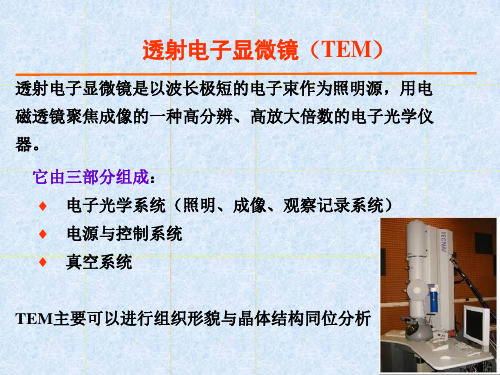
碳膜复型又有 碳膜一次复型 和塑料-碳膜二 级复型两种方 法。
电子衍射
在电子成像系统中: 使中间镜物平面与物镜像平面重合(成像操作),
在观察屏上得到的是反映样品组织形态的形貌图像; 而使中间镜的物平面与物镜背焦面重合(衍射操
作),在观察屏上得到的则是反映样品晶体结构的衍射斑点。
电子衍射的原理和X射线衍射相似,是以满足布拉格方程作为 产生衍射的必要条件。衍射花样:
• 日本岗山大学H. Hashimoto日本电镜研 究的代表人。
• 瑞典斯德哥尔摩大学Osamu Terasaki,多 孔材料分析“世界第一人”。
• 中国:钱临照、郭可信、李方华、叶恒 强、朱静。
• 国内电镜做得好的有:北京电镜室(物 理所)、沈阳金属所、清华大学、上海 硅酸盐所。
为什么要用TEM?
照片示例(TEM与HRTEM图片)
TiO2的TEM(左)和HRTEM(右)图片
图片示例(ZnO的TEM和HRTEM图片)
涂层、薄膜照片 SiO2/ZrO2 multilayers (bar=50nm)
SiO2 ZrO2
(a)
(b)
(c)
TEM images of spinel film on SiO2 amorphous layer obtained in bright field (a), in dark field (b) and electron
High resolution transmission electron microscopy for a destabilized cadmium sulfide (CdS) sol of 4-5 nm particle size. Collapsed particles are clearly observed. It can also be been that the particles are highly crystalline.
TEM原理构造1
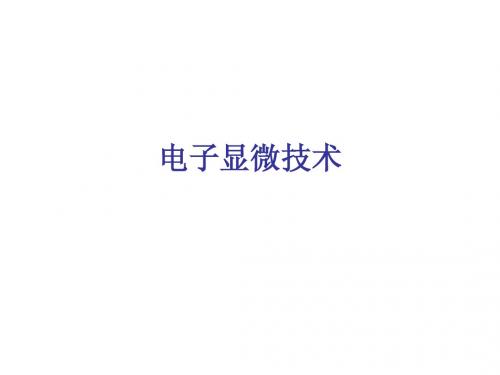
色差
色差:是由于入射电子波长(或能量) 色差:是由于入射电子波长(或能量)的非单一
性造成。 性造成。
电磁透镜
• 电磁透镜的聚焦原理 电磁透镜的聚焦原理: • 通电的短线圈就是一个简单的电磁透镜,它能造 通电的短线圈就是一个简单的电磁透镜, 成一种轴对称不均匀分布的磁场。 成一种轴对称不均匀分布的磁场。 • 穿过线圈的电子在磁场的作用下将作圆锥螺旋近 轴运动。 轴运动。 • 而一束平行于主轴的入射电子通过电磁透镜时将 被聚焦在主轴的某一点。 被聚焦在主轴的某一点。 • 下图为一种实际常用的带有铁壳以及极靴的电磁 透镜示意图。 透镜示意图。
λ=
h 2em0U
将常数代入上式, 将常数代入上式,并注意到电子电荷 e 的单位为 库仑, 的单位为 的单位为J·s,我们将得到: 库仑, h的单位为 ,我们将得到:
1.226 U
λ=
[nm] ]
表4-1不同加速电压下的电子波长 不同加速电压下的电子波长
20 30 50 100 200 500 1000 加速电压/kV 加速电压 电子波长/10 电子波长 -6nm 8.59 6.98 5.36 3.70 2.51 1.42 0.687
• 如果计算分辨本领的平面为最小截面圆所 在平面, 在平面,则 ∆r’s=1/4 Csα3 从以上两式可以得知∆r’s或∆rs与球差系数 或 从以上两式可以得知 与球差系数 Cs成正比,与孔径半角的立方成正比。 成正比, 成正比 与孔径半角的立方成正比。 • 也就是说球差系数越大,由球差决定的分 也就是说球差系数越大, 辨本领越差,随着α的增大 的增大, 辨本领越差,随着 的增大,分辨本领也急 剧地下降。 剧地下降。
电磁透镜的分辨本领
• 电磁透镜的分辨本领由衍射效应和球面像差 来决定。 来决定。 • 衍射效应对分辨本领的影响: 衍射效应对分辨本领的影响: Rayleigh公式: 公式: 公式 ∆r0=0.61λ/Nsinα • ∆r0:成像物体上能分辨出来的两个物点间 : 的最小距离,表示透镜分辨本领的大小。 的最小距离,表示透镜分辨本领的大小。 λ:波长 N:介质的相对折射系数 :波长; α:透镜的孔径半角 透镜的孔径半角
材料研究方法之TEM
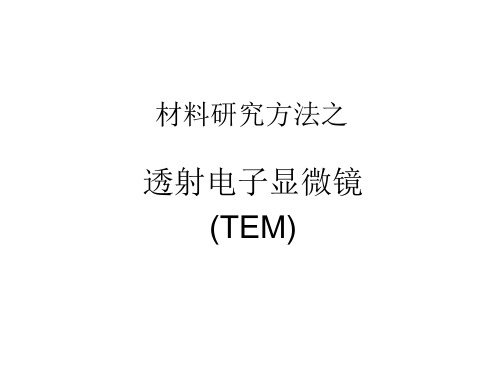
照相软片(用于ED(电子衍射图))和CCD CCD:可以方便地使用多种信息处理手段
2.光路图
TEM ,ED, NBD( 纳米束衍射)(CBD)EDS模式,低倍模式, 自由透 镜组合
物 物镜
(物镜光阑)
(焦平面) 衍射谱
一次像 中间镜
(视场光阑)
Sr La (raw)
O Ka (raw)
Overlay (raw)
1.0 nm Ti Ka (averaged)
Sr La (averaged)
O Ka (averaged)
Overlay (averaged)
ELNES analysis at atomic level
High current probe damaged the specimen
b 材料显微结构的表征,如材料的形貌、尺度、晶界、相界、孪晶、层错、位错、 取向关系等等,在一定条件下,可获得材料相变过程及显微结构变化的信息。
c 高分辨晶格点阵像和原子结构像的获得,可揭示材料在原子分辨尺度上的显微 结构细节,对物相鉴定,结构表征更有助益。
d 利用X射线能谱对材料的微小区域进行定量分析,把材料的结构研究和成分分 析结合起来,有益于对材料的全面了解。
使用我们的电镜能得到下列结果:
质厚衬度像
等厚度样品的衍射衬度像
二维晶格点阵像
二维结构像
元素
O S Zn
谱峰 面积 181 746 1131
面积 Sigma 36 58 64
k 因子 1.547 0.803 1.225
Abs 校正 1.000 1.000 1.000
重量百分比
12.37 26.45 61.18
现代测试分析技术SEM、TEM、表面分析技术、热分析技术
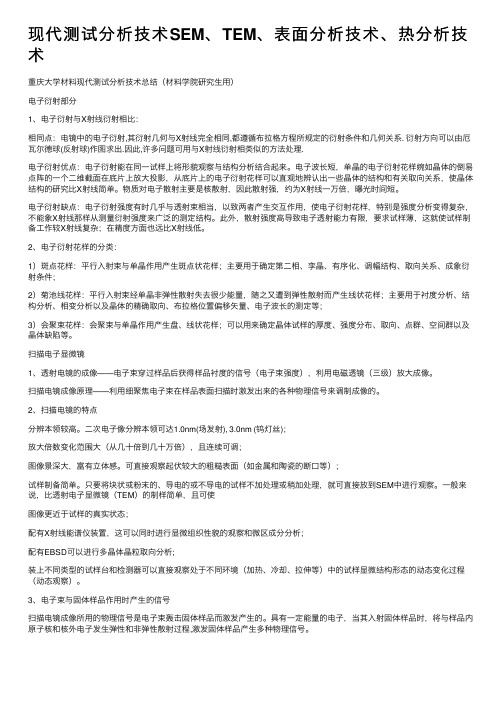
现代测试分析技术SEM、TEM、表⾯分析技术、热分析技术重庆⼤学材料现代测试分析技术总结(材料学院研究⽣⽤)电⼦衍射部分1、电⼦衍射与X射线衍射相⽐:相同点:电镜中的电⼦衍射,其衍射⼏何与X射线完全相同,都遵循布拉格⽅程所规定的衍射条件和⼏何关系. 衍射⽅向可以由厄⽡尔德球(反射球)作图求出.因此,许多问题可⽤与X射线衍射相类似的⽅法处理.电⼦衍射优点:电⼦衍射能在同⼀试样上将形貌观察与结构分析结合起来。
电⼦波长短,单晶的电⼦衍射花样婉如晶体的倒易点阵的⼀个⼆维截⾯在底⽚上放⼤投影,从底⽚上的电⼦衍射花样可以直观地辨认出⼀些晶体的结构和有关取向关系,使晶体结构的研究⽐X射线简单。
物质对电⼦散射主要是核散射,因此散射强,约为X射线⼀万倍,曝光时间短。
电⼦衍射缺点:电⼦衍射强度有时⼏乎与透射束相当,以致两者产⽣交互作⽤,使电⼦衍射花样,特别是强度分析变得复杂,不能象X射线那样从测量衍射强度来⼴泛的测定结构。
此外,散射强度⾼导致电⼦透射能⼒有限,要求试样薄,这就使试样制备⼯作较X射线复杂;在精度⽅⾯也远⽐X射线低。
2、电⼦衍射花样的分类:1)斑点花样:平⾏⼊射束与单晶作⽤产⽣斑点状花样;主要⽤于确定第⼆相、孪晶、有序化、调幅结构、取向关系、成象衍射条件;2)菊池线花样:平⾏⼊射束经单晶⾮弹性散射失去很少能量,随之⼜遭到弹性散射⽽产⽣线状花样;主要⽤于衬度分析、结构分析、相变分析以及晶体的精确取向、布拉格位置偏移⽮量、电⼦波长的测定等;3)会聚束花样:会聚束与单晶作⽤产⽣盘、线状花样;可以⽤来确定晶体试样的厚度、强度分布、取向、点群、空间群以及晶体缺陷等。
扫描电⼦显微镜1、透射电镜的成像——电⼦束穿过样品后获得样品衬度的信号(电⼦束强度),利⽤电磁透镜(三级)放⼤成像。
扫描电镜成像原理——利⽤细聚焦电⼦束在样品表⾯扫描时激发出来的各种物理信号来调制成像的。
2、扫描电镜的特点分辨本领较⾼。
⼆次电⼦像分辨本领可达1.0nm(场发射), 3.0nm (钨灯丝);放⼤倍数变化范围⼤(从⼏⼗倍到⼏⼗万倍),且连续可调;图像景深⼤,富有⽴体感。
材料现代研究方法ModernMethodsofMaterialsAnalysis

EPMA
島津EPMA-1600
EDS应用举例
不良品 良 品
C
浸炭不 良部
不良品
齿轮疲劳失效,是由于 渗碳处理不均匀,根本 原因在于硅的偏聚。
良 品
Si
XPS
3. 4 分子结构分析
利用电磁波与分子键和原子核的作用,获 得分子结构信息。红外光谱(IR)、拉曼 光谱(Raman)、 荧光光谱(PL)等是 利用电磁波与分子键作用时的吸收或发射 效应,而核磁共振(NMR)则是利用原 子核与电磁波的作用来获得分子结构信息 的。
3.1组织形貌分析
微观结构的观察和分析对于理解材料的本 质至关重要,组织形貌分析借助各种显微 技术,认识材料的微观结构。表面形貌分 析技术经历了光学显微镜(OM)、电子显 微镜(SEM)、扫描探针显微镜(SPM)的发 展过程,现在已经可以直接观测到原子的 图像。
三种组织分析手段的比较
扫描探针显微镜 观察倍率
利用衍射分析的方法探测晶格类型和晶胞常数, 确定物质的相结构。 主要的物相分析的手段有三种:x射线衍射 (XRD)、电子衍射(ED)及中子衍射(ND)。 其共同的原理是: 利用电磁波或运动电子束、 中子束等与材料内部规则排列的原子作用产生 相干散射,获得材料内部原子排列的信息,从 而重组出物质的结构。
1.材料现代分析方法
材料现代分析方法是关于材料分析测试技术及其有关理论的 一门课程。 成分、结构、加工和性能是材料科学与工程的四个基本要素, 成分和结构从根本上决定了材料的性能,对材料的成分和结 构的进行精确表征是材料研究的基本要求,也是实现性能控 制的前提。
2.材料分析的内容
表面和内部组织形貌。包括材料的外观形貌(如纳米 线、断口、裂纹等)、晶粒大小与形态、各种相的尺 寸与形态、含量与分布、界面(表面、相界、晶界)、 位向关系(新相与母相、孪生相)、晶体缺陷(点缺 陷、位错、层错)、夹杂物、内应力。 晶体的相结构。各种相的结构,即晶体结构类型和晶 体常数,和相组成。 化学成分和价键(电子)结构。包括宏观和微区化学 成份(不同相的成份、基体与析出相的成份)、同种 元素的不同价键类型和化学环境。 有机物的分子结构和官能团。
抗人肿瘤内皮标志物1 ( TEM1)抗体的表达及活性鉴定

细胞与分子免疫学杂志(Chin J Cell Mol Immunol)2020,36(12)1129•论著•文章编号:1007-8738(2020)12-1129-05抗人肿瘤内皮标志物1(TEM1)抗体的表达及活性鉴定张玲玲',吴介恒S韩东晖',杨发S郑国旭S席文锦-郭张燕-杨安钢2,秦卫军顼,温伟红仆(空军军医大学:I西京医院输血科J基础医学院免疫学教研室,彳西京医院泌尿外科,陕西西安710032;°西北工业大学医学研究院,陕西西安710072)[摘要]目的构建抗人肿瘤内皮标志物1(TEM1)全抗体IgG78的真核表达载体,进行表达纯化后鉴定其生物学活性。
方法利用PCR分别从单链抗体ScFv78中扩增TEM1抗体的轻、重链可变区基因,并克隆入带有小鼠抗体恒定区的真核表达载体Bichim-L,瞬时转染HEK293F细胞,表达产物用蛋白G亲和层析柱进行纯化,所得蛋白用SDS-PAGE和Western blot法进行鉴定,采用流式细胞术和活细胞ELISA检测该抗体与TEM1阳性细胞的结合特异性及亲和力。
结果成功构建了TEM1全抗体IgG78的真核表达载体,并在HEK293F细胞中表达。
SDS-PAGE和Western blot法证实目的蛋白符合预期大小,流式细胞术及细胞ELISA结果显示该抗体可特异性结合TEM1阳性肿瘤细胞,且有较高的亲和力。
结论成功获得了一株具有良好结合特异性和较高亲和力的TEM1抗体。
[关键词]肿瘤内皮标志物1(TEM1);CD248;抗体;HEK293F细胞;真核表达[中图分类号]R392.ll,R730.51,R392-33[文献标志码]A肿瘤内皮标志物1(tumor endothelial marker1, TEM1),又称内皮唾液酸蛋白或CD248,人TEM1基因定位于染色体Hql3,其编码的TEM1蛋白相对分子质量(他)为165000,是一种单链跨膜糖蛋白⑷。
1.阐述tem表征手段的原理及适用范围。

1.阐述tem表征手段的原理及适用范围。
【如何深度阐述tem表征手段的原理及适用范围】一、前言主题:tem表征手段的原理及适用范围在当今科技发展迅猛的时代,电子显微镜成为了科学研究和工程领域中必不可少的重要工具。
其中,透射电子显微镜(Transmission Electron Microscope, TEM)作为一种精密、高分辨率的观测和表征工具,广泛应用于材料科学、纳米科学、生物学等领域。
本文将深入探讨TEM表征手段的原理及适用范围,以期为读者提供全面、深刻的理解。
二、 TEM表征手段的原理1. 原理概述TEM是一种基于电子束穿透样品的表征手段。
通过加速电子至高能状态,使其穿透样品并被激发,然后通过透射电子显微镜的透镜系统进行成像和分析。
其基本原理类似于光学显微镜,但由于电子具有极高的波长决议能力,因此TEM的分辨率远超过光学显微镜。
2. 具体操作在TEM中,电子束穿过样品后会产生透射电子,这些透射电子携带有样品内部信息,并通过透射电子显微镜的透镜系统进行成像。
通过透射电子的散射、衍射等现象,可以获取样品的高分辨率结构信息。
三、 TEM表征手段的适用范围1. 材料科学领域在材料科学领域,TEM可用于分析材料的微观结构、晶体结构和缺陷等。
通过TEM高分辨率的成像能力,可以观察到纳米级甚至更小尺度的微观结构,为新材料的设计和研发提供重要信息。
2. 纳米科学与纳米技术领域在纳米科学与纳米技术领域,TEM可用于观测纳米颗粒、纳米线、纳米管等纳米结构的形貌和结构特征,并对纳米材料的性能进行表征。
TEM还可用于纳米器件的制备、表征和优化过程中的微观观察。
3. 生物学与医学领域在生物学与医学领域,TEM可用于观察生物细胞、病毒、蛋白质等生物样品的微观结构和组织形态,为研究细胞生物学、病毒学等提供重要参考数据。
四、个人观点和总结通过对TEM表征手段的原理及适用范围的深入探讨,可以看出其在科学研究和工程应用中的重要性。
1-TEM
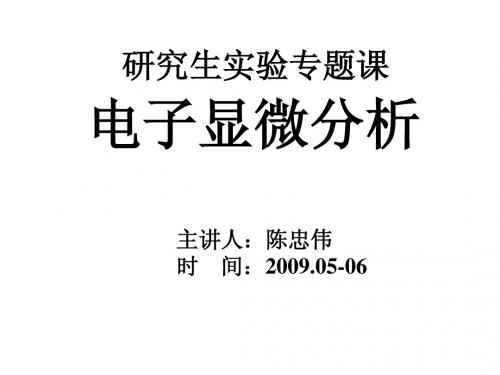
整理并代入数据:
12.25 eU 2em0U 1 2m c 2 0 U 1 0.9788106 U
12.25
(1+0.9788 10-6U)为相对论修正因子
从表中可知,电子波长比可见光波长 短得多。以电子显微镜中常用的80~200kV 的电子波长来看,其波长仅为0.00418~ 0.00251nm,约为可见光波长的十万分之 一。 如果仅考虑衍射效应对仪器分辨本领 的影响,那末电子显微镜的极限分辨本领 应为10-3nm。但是,目前能达到的最佳分 辨本领是10-1nm ,比极限分辨本领约差 100倍。
mv
一个初速为零的电子(电荷为e)在电场中从电位为零处开始运 动,因受加速电压U(阴极和阳极之间的电位差)的作用获得运动速 度为v,那么加速每个电子所作的功(eU)就是电子获得的全部动能, 即:
eU 1 2 mv 2源自v2eU m加速电压比较低时,电子运动的速度远小于光速(vc) ,它的 质量近似等于电子的静止质量,即m=m。,则:
r0 1 2
以上说明,透镜可分辨的两点间的最小距离即分辨本领主要取决 于照明波长。可见光的波长在390~760nm之间,最佳情况下,光 学玻璃透镜的分辨本领极限值可达200nm,人眼的分辨本领约 0.2mm, 所以光学显微镜的有效放大倍数为1000倍。
电子的波长
1924年,德布罗意鉴于光的波粒二象性,提出这样一个假设:运 动的实物粒子(静止质量不为零的那些粒子:电子、质子、中子等) 都具有波动性质。后来被电子衍射实验所证实。运动电子具有波 动性使人们想到可以用电子束作为电子显微镜的光源。对于运动 速度为v,质量为m的电子波长: h h=普朗克常数
电子束在电磁透镜中的折射行为和可见光在玻璃透镜中的折射相似, 满足下面性质: (1)通过透镜光心的电子束不发生折射 (2)平行于主轴的电子束,通过透镜后聚焦在主轴上一点F, 即焦点。 经过焦点并垂直于主轴的平面称为焦平面 (3)一束与某一副轴平行的电子束通过透镜后将聚焦于该副轴与焦 平面的交点上。 当电磁透镜的物距、像距、焦距分别为L1,L2,f,三者之间关系 以及放大倍率M均与玻璃薄透镜相同: 1/ L1 =1/ L2 =1/f, M= L2 /L1, M=f /(L1 - f), M=(L2 - f) / f 根据经验公式
TEM-1型β-内酰胺酶编码基因的克隆表达
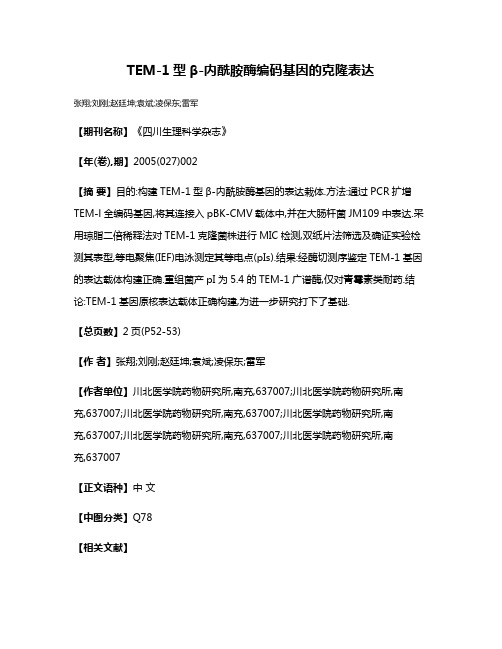
TEM-1型β-内酰胺酶编码基因的克隆表达张翔;刘刚;赵廷坤;袁斌;凌保东;雷军【期刊名称】《四川生理科学杂志》【年(卷),期】2005(027)002【摘要】目的:构建TEM-1型β-内酰胺酶基因的表达栽体.方法:通过PCR扩增TEM-l全编码基因,将其连接入pBK-CMV载体中,并在大肠杆菌JM109中表达.采用琼脂二倍稀释法对TEM-1克隆菌株进行MIC检测,双纸片法筛选及确证实验检测其表型,等电聚焦(IEF)电泳测定其等电点(pIs).结果:经酶切测序鉴定TEM-1基因的表达载体构建正确.重组菌产pI为5.4的TEM-1广谱酶,仅对青霉素类耐药.结论:TEM-1基因原核表达载体正确构建,为进一步研究打下了基础.【总页数】2页(P52-53)【作者】张翔;刘刚;赵廷坤;袁斌;凌保东;雷军【作者单位】川北医学院药物研究所,南充,637007;川北医学院药物研究所,南充,637007;川北医学院药物研究所,南充,637007;川北医学院药物研究所,南充,637007;川北医学院药物研究所,南充,637007;川北医学院药物研究所,南充,637007【正文语种】中文【中图分类】Q78【相关文献】1.TEM型β内酰胺酶新亚型TEM-166编码基因的克隆表达 [J], 王慧;熊自忠;李睿2.同时产PER-1型和TEM-1型β内酰胺酶铜绿假单胞菌的检出 [J], 侯天文;尹晓琳;王永祥;陈兴;李烛;张林;李玮3.TEM-1型β-内酰胺酶及CarO蛋白介导的耐舒巴坦鲍曼不动杆菌临床株耐药机制研究 [J], 李楠;张豪杰;王悦;祁萌;郭文学;王哲;祁伟4.TEM-1型β-内酰胺酶基因的克隆、表达及酶的纯化 [J], 孙伟;龚家玮;朱春宝;朱宝泉5.产DHA-1型AmpC酶和TEM-1型β-内酰胺酶及携带Ⅰ类整合子的鲍氏不动杆菌 [J], 侯天文;尹晓琳;马翠卿;徐树彬;陈晶;陈兴;李玮;白云因版权原因,仅展示原文概要,查看原文内容请购买。
材料的现代研究方法

材料的现代研究方法
现代材料研究方法包括以下几个方面:
1. 材料表征方法:包括扫描电子显微镜(SEM)、透射电子显微镜(TEM)、X 射线衍射(XRD)、原子力显微镜(AFM)等表征手段,用于分析材料的形貌、结构、晶体学等特征。
2. 热分析方法:包括差示扫描量热法(DSC)、热重分析法(TGA)、热导率测量、热膨胀测量等,用于研究材料的热性质和相变过程。
3. 光谱学方法:包括红外光谱(IR)、拉曼光谱、紫外可见光谱(UV-Vis)、核磁共振(NMR)等方法,用于分析材料的化学组成和分子结构。
4. 表面分析方法:包括X射线光电子能谱(XPS)、扫描隧道显微镜(STM)、原子力显微镜(AFM)等技术,用于表征材料表面的化学组成和形貌。
5. 电化学方法:包括循环伏安法(CV)、电化学阻抗谱(EIS)等,用于研究材料的电化学性质和电化学反应过程。
6. 计算模拟方法:包括分子动力学模拟(MD)、密度泛函理论(DFT)等计算方法,用于预测材料的性质、模拟材料的结构和动力学过程。
这些现代研究方法互相结合,可以全面了解材料的结构、性质和功能,为材料科学的发展提供重要的支持。
TEM技术在材料科学中的应用
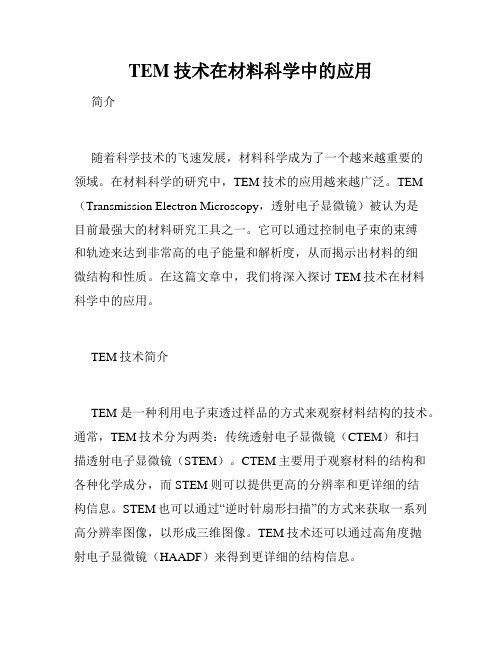
TEM技术在材料科学中的应用简介随着科学技术的飞速发展,材料科学成为了一个越来越重要的领域。
在材料科学的研究中,TEM技术的应用越来越广泛。
TEM (Transmission Electron Microscopy,透射电子显微镜)被认为是目前最强大的材料研究工具之一。
它可以通过控制电子束的束缚和轨迹来达到非常高的电子能量和解析度,从而揭示出材料的细微结构和性质。
在这篇文章中,我们将深入探讨TEM技术在材料科学中的应用。
TEM技术简介TEM是一种利用电子束透过样品的方式来观察材料结构的技术。
通常,TEM技术分为两类:传统透射电子显微镜(CTEM)和扫描透射电子显微镜(STEM)。
CTEM主要用于观察材料的结构和各种化学成分,而STEM则可以提供更高的分辨率和更详细的结构信息。
STEM也可以通过“逆时针扇形扫描”的方式来获取一系列高分辨率图像,以形成三维图像。
TEM技术还可以通过高角度抛射电子显微镜(HAADF)来得到更详细的结构信息。
TEM技术的应用TEM技术在材料科学中的应用非常广泛,以下是一些常见的应用:1. 结构分析TEM可以用于观察纳米尺寸的材料,如纳米晶体、纳米管、纳米粒子等,从而揭示它们的结构和性质。
通过TEM,可以获得材料在原子尺度上的详细信息,如颗粒的大小和形状、材料中的晶粒和缺陷等。
2. 化学成分分析TEM还可以用于分析材料的化学成分。
通过在TEM中使用EDS(Energy Dispersive Spectroscopy,能谱分析),可以分析材料中的元素成分。
这对于了解材料的制备方法和性能非常重要。
3. 电子显微学TEM可以用于观察材料中电子的行为。
例如,观察电子在半导体材料中的行为可以帮助我们理解半导体材料的电子结构和性能。
4. 动态行为TEM还可以用于观察材料的动态行为,如材料的生长、变形、熔化等。
通过TEM,我们可以观察到材料的微观细节,从而揭示材料的行为和性能。
5. 生物材料研究TEM也可以用于研究生物材料,如细胞、蛋白质、DNA等。
TEM-1β内酰胺酶介导的大肠埃希菌对哌拉西林-他唑巴坦和头孢哌酮耐药机制的研究
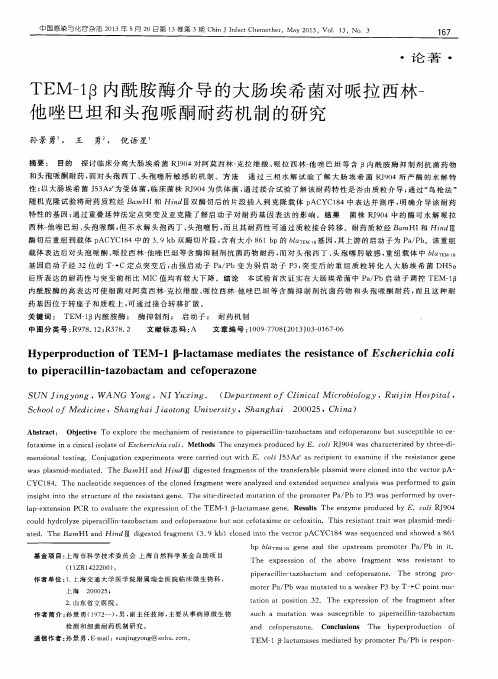
摘要 : 目的 探 讨 临床 分 离 大 肠 埃 希 菌 R J 9 0 4对 阿莫 西 林 一 克 拉维酸 、 哌拉 西林一 他 唑 巴 坦 等 含 p内 酰 胺 酶 抑 制 剂 抗 菌 药 物
和头孢哌酮耐药 , 而对头孢西丁 、 头 孢 噻 肟 敏 感 的机 制 。方 法 通 过 三 相 水 解 试 验 了解 大 肠 埃 希 菌 R J 9 0 4所 产 酶 的 水 解 特 性; 以大 肠 埃 希 菌 J 5 3 A z 为受体菌 , 临床菌株 R J 9 0 4为 供 体 菌 , 通 过 接 合 试 验 了解 该 耐 药 特 性 是 否 由 质 粒 介 导 ; 通 过“ 鸟枪法” 随机克隆试验将耐药质粒经 B a mHI 和 Hi n dⅢ双 酶 切后 的 片 段 插 入 到 克 隆 载 体 p A C YC 1 8 4中表 达 并 测 序 , 明 确 介 导 该 耐 药 特性 的基 因 ; 通 过 重 叠 延 伸 法 定 点 突 变 及 亚 克 隆 了解 启 动 子 对 耐 药 基 因 表 达 的 影 响 。 结 果 菌 株 R J 9 0 4中 的 酶 可 水 解 哌 拉
Ab s t r a c t : 0b j e c t i v e To e x p l o r e t h e me c h a n i s m o f r e s i s t a n c e t o p i p e r a c i l l i n - t a z o b a c t a m a n d e e f o p e r a z o n e b u t s u s c e p t i b l e t o c e —
后 所 表 达 的 耐 药 性 与 突 变 前 相 比 MI C值 均 有 较 大 下 降 。 结 论
- 1、下载文档前请自行甄别文档内容的完整性,平台不提供额外的编辑、内容补充、找答案等附加服务。
- 2、"仅部分预览"的文档,不可在线预览部分如存在完整性等问题,可反馈申请退款(可完整预览的文档不适用该条件!)。
- 3、如文档侵犯您的权益,请联系客服反馈,我们会尽快为您处理(人工客服工作时间:9:00-18:30)。
The indices of a plane and its normal in hex crystals
2.1. 电子衍射(Electron diffraction) 2.2. 选区电子衍射(Selected area electron diffraction (SAD)) 2.3. 相机常数(Camera constant) 2.4. 简单电子衍射花样的标定(Indexing of simple SAD patterns) 2.5. 衍射花样的形状效应(Shape effect of diffraction patterns) 2.6. 取向关系(Orientation relationship) 2.7. 入射束方向的精确确定 (Accurate determination of beam direction) 2.8. 复杂衍射花样(Complicated SAD patterns) 2.9 偏移参数(Deviation parameter sg)
hkl → uvw :
u v 2w c 2 ( ) 2h k h 2k 3l a
Weiss’s Zone Law
1. Basic law: hu + kv + lw = 0 . 2. Addition rule If (h1k1l1) and (h2k2l2) belong to [uvw], then (h3k3l3) also belongs to [uvw] when: h3 = ±nh1 ± mh2 k3 = ±nk1 ± mk2 l3 = ±nl1 ± ml2 3. Zone axis If (h1k1l1) and (h2k2l2) belong to [uvw], then: [uvw] = (h1k1l1) x (h2k2l2) or u = k1l2 – k2l1 v = l1h2 – l2h1 w = h1k2 – h2k1 4. If a plane (hkl) contains the zone axis [u1v1w1] and [u2v2w2], then: (hkl) = (u1v1w1) x (u2v2w2) or h = v1w2 – v2w1 k = w1u2 – w2u1 l = u1v2 – u2v1
现代材料研究方法
引言:
1. 现代材料科学 2. 材料科学发展趋势 3. 电子显微镜及微区分析在材料科学研究中的作用
材料科学概念
加工 性能 性能
成本(性能、价格比) 成本
加工 成份 成份 组织 性能 加工 成份 组织 性能
组织
成份 组织
环境
材料科学发展趋势
• 传统材料(Traditional materials): 提高性能/价格比 • 先进材料 (Advanced materials): 用于各种极端条件 • 功能材料(Functional materials) • 低维材料( Low dimension materials) • 纳米技术和纳米材料(Nano technology and nano materials) • 生物医学材料(Biomaterials) • 环境材料(Environmental materials) • …………….
2.4.1尝试校核法( Trier and error: ) 2.4.2 已知相机常数法(Known camera constant) 2.4.3 标准衍射谱法(Standard diffraction patterns) 2.4.4 计算机标定法(Computer simulation)
R1 2 N1 h12 k12 l12 ( ) 2 2 2 R2 N 2 h2 k 2 l2
1. 引言(Introduction)
1.1. 阿贝成象理论(Abby’s theory of image formation) 1.2. 电子显微镜(Electron microscope) 1.3. 衬度的起源(Origin of image contrast) 1.4. 电镜图像举例(Examples of electron microscopy photographs)
2.5. 衍射花样的形状效应 Shape effect of diffraction patternslationship)
2.7. 入射束方向的精确确定 Accurate determination of beam direction
1. Electron Microscopy of Thin Crystals, M.A.Hirsh et al., 1977 2. Transmission Electron Microscopy of Materials, G.Thomas, 1979 3. Practical Electron Microscopy in Materials Science, J.W. Edington,1974-77 4. Defect Analysis in Transmission Electron Microscopy, R.E.Smallman, 1980 5. 电子衍射图在晶体学中的应用, 郭可信等 6. 金属电子显微分析, 上海交大
2.1. 电子衍射(Electron diffraction)
2.2. 选区电子衍射(Selected area electron diffraction (SAD))
2.3. 相机常数(Camera constant)
Ll 叫作相机常数, 且 dhkl = Ll /R’
2.4 简单SAD花样的标定(Indexing of simple SAD patterns)
2.8. Indexing of simple SAD patterns from hex crystals
2.8.1 Weiss’s zone law 2.8.2 Application of Weiss’s zone law to hex system 2.8.3 Three axis and four axis system for hex crystals 2.8.4 The indices of a plane and its normal in hex crystals
本课程的内容:
Part I 透射电子显微学及其在材料科学研究中的应用 Part II 高分辩电子显微学及其在材料科学研究中的应用 Part III 分析电子显微学及其在材料科学研究中的应用
Part I 透射电镜及其在材料科学研究中应用
1. 引言 2. 电子衍射(Electron diffraction) 3. 衍衬理论(Theory of diffraction contrast) 4. 完整晶体的特征图像(Characteristic images from perfect crystals) 5. 位错和层错的衬度(Contrast from dislocations and stacking faults) 6. 第二相粒子的衬度(Contrast from second phase particles) 参考资料(References) :
EM1 Electron Diffraction Patterns
(1) Photograph A is from one grain of a thin foil of a-iron. Choose one spot as the origin and measure the distance of a number of adjacent spots from it. It is always helpful to make a reasonable sketch of the pattern and to label the spots. From the ratio of the distances between the origin and the measured spots, and the known possibilities for values of , assign a consistent set of indices to all the spots and hence determine the indices of the direction of the electron beam. Given that the unit cell dimension of a-iron is 2.86 Å, what is the "camera constant" for the photograph? (2) Index the pattern B given that it is from aluminum, a= 4.04 Å and that the camera constant is approximately 4.4 cm. Å (3) The diffraction pattern C is from a-iron containing precipitates of CrN (fcc, a= 4.15 Å which have a definite orientation relationship with the matrix. The precipitates occur as thin plates on the three sets of (100)a planes so there are three precipitate patterns present on the photograph. The sketch D shows only one precipitate pattern, plus the matrix pattern. Note the symmetry of the matrix pattern and index it by inspection. Index the precipitate pattern and determine the orientation relationship between precipitate and matrix. Account for the observed morphology of the precipitate particles.
